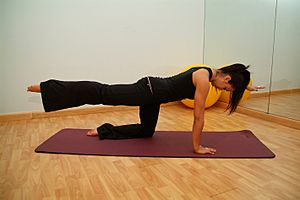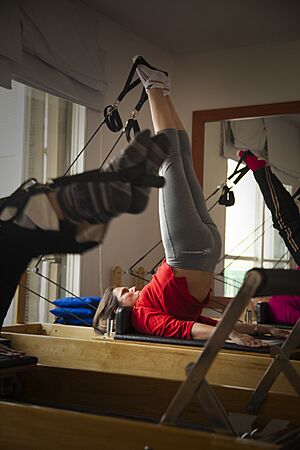Pilates facts for kids
Pilates (say "pih-LAH-teez") is a special type of exercise that connects your mind and body. It was created in the early 1900s by a German physical trainer named Joseph Pilates. He called his method "Contrology," because it focuses on controlling your body's movements.
Many people around the world practice Pilates, especially in countries like Australia, Canada, and the United States. Pilates uses about 50 different exercises that you repeat several times. These exercises focus on important ideas like breathing, good posture, and using your core muscles.
While Pilates can make your muscles stronger and improve your balance, there isn't much proof that it can cure health problems like back pain. It's a great way to get fit, but it's not a medical treatment.
Contents
How Pilates Started
Pilates was developed by Joseph Pilates, who was from Germany. His father was a gymnast, and his mother was a naturopath, someone who uses natural remedies for health.
Joseph Pilates said he got the idea for his method during World War I. He was held in a camp on the Isle of Man. For four years, he worked with other people in the camp. He developed his system of exercises to make both the mind and body stronger. He believed that your mental and physical health were connected.
When he was young, Joseph Pilates tried many different types of physical training popular in Germany. He used these ideas to create his own method. His exercises were similar to other fitness programs from the late 1800s. These programs often used special equipment and claimed to help with health problems.
Pilates Equipment
Joseph Pilates also created special equipment for his method. He called these "apparatuses." Each piece of equipment was designed to help you stretch, strengthen, and improve your body's alignment. They also helped build core strength, which is the strength in your stomach, back, and hip muscles.
The most famous piece of equipment is the Reformer. Joseph Pilates first called it the Universal Reformer. He chose this name because it was great for "universally reforming the body." He also designed other equipment like the Cadillac, Wunda Chair, and Spine Corrector.
Joseph Pilates wrote two books about his training method. They were called Your Health (1934) and Return to Life Through Contrology (1945).
What is Pilates?
Experts describe Pilates as an exercise that connects your mind and body. It requires strong core muscles, strength, and flexibility. It also focuses on controlling your muscles, good posture, and breathing.
The New York Times says that Pilates can be changed to fit different fitness goals, ages, and abilities. Pilates is not a cardio workout that makes your heart race. Instead, it's a workout for strength and flexibility.
One big difference between Pilates and other exercises is its focus on breathing. Joseph Pilates said, "Above all, learn how to breathe correctly." People doing Pilates use their core and breath for every movement.
In his book, Joseph Pilates explained his method as an art of controlled movements. He said it should feel like a workout, not a therapy. If you practice Pilates regularly, it can make you more flexible and stronger. It also helps you control your body and build endurance. Pilates focuses on good body alignment, breathing, and building a strong core. Your core muscles are often called the "powerhouse." They are key to your body's stability.
Pilates exercises can be made easier or harder. This means they can fit beginners, advanced students, or anyone in between. The intensity can increase as your body gets stronger. Today, many different versions of Pilates are taught. Most of them follow up to nine main principles.
Mat and Reformer Pilates
Pilates keeps changing with new equipment. However, the main ideas come from the movements Joseph Pilates created. You can do Pilates on a mat or with special machines.
Pilates often uses machines called reformers. These machines have a frame, a sliding platform, springs, straps, and pulleys. They help support your spine and work different muscle groups. For example, to work your upper back, you might lie face-down on a long box on the sliding platform. You then lift your head and chest while pulling straps to slide forward. The springs control how much resistance you feel.
With mat Pilates, you use your body weight as the main resistance. You sit or lie on the floor, using gravity to help stabilize your core. A common mat exercise is the "roll-up." You start by sitting on the floor with your legs straight. Then you slowly uncurl your upper body backward until you are lying flat. You then curl back up to the start. You use your breath to control these movements.
You can also use small accessories like resistance rings or bands in both mat and reformer Pilates.
Pilates vs. Yoga
Modern yoga is also a mind-and-body exercise, like Pilates. However, yoga classes often talk more about spiritual ideas. Both yoga and Pilates include stretching and breathing. They are both low-impact exercises, meaning they are gentle on your joints. But there are some key differences.
In yoga, you hold certain poses for longer times and then smoothly move into others. In Pilates, you move your arms or legs while staying in certain positions. In yoga, breathing helps you relax and hold poses. In Pilates, breathing helps give your muscles more energy. Most Pilates exercises start with you lying down. Most yoga poses start with you standing up.
Some poses in both are very similar. For example, the Pilates "roll over" is like the yoga "plough pose." Both Pilates and yoga help you build strength, flexibility, and fitness. However, Pilates focuses more on core strength, while yoga focuses more on flexibility.
Legal Status of Pilates
The term "Pilates" is not officially regulated by a professional group.
In 2000, a U.S. court decided that "Pilates" is a general term. This means anyone can use it freely. The word is still capitalized because it comes from the name of its founder, Joseph Pilates.
After this court decision, the Pilates Method Alliance was created. This group helps connect Pilates teachers, studios, and trainers around the world. Their goal is to keep Joseph Pilates' method alive and strong. They also work to set standards and promote professionalism in the Pilates community.
See also
- Calisthenics
- Meditation
- Squatting position
- Yoga





